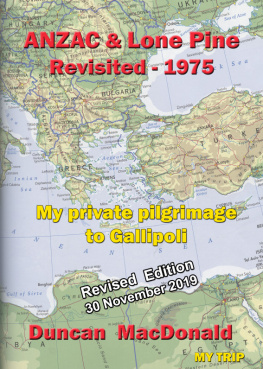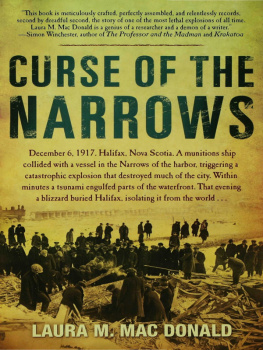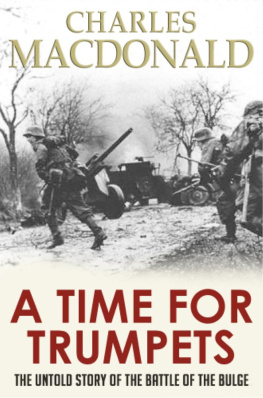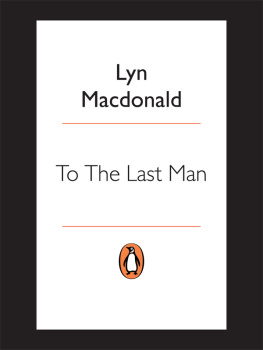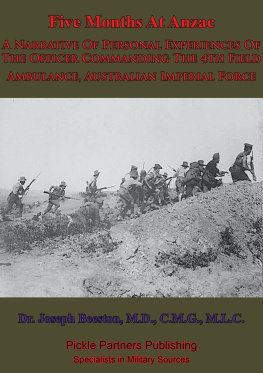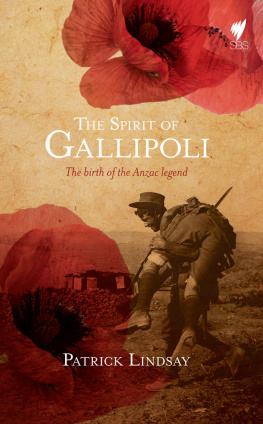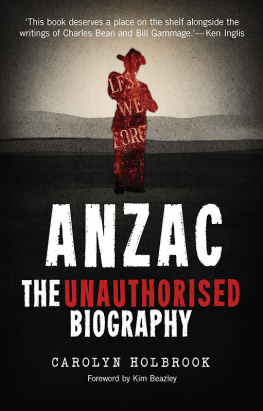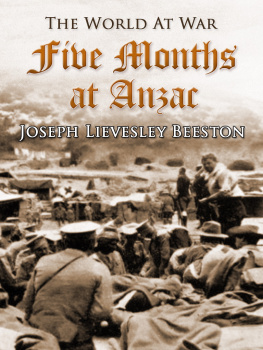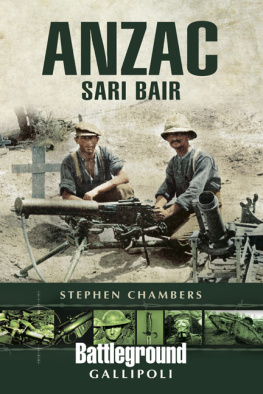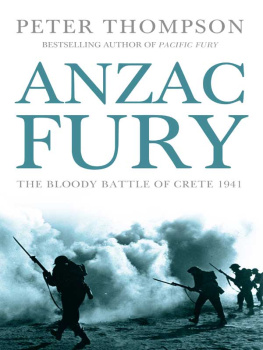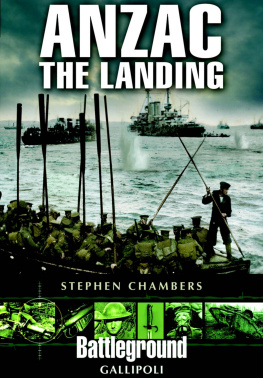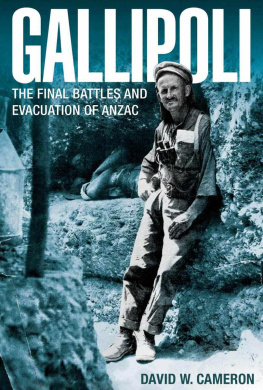Anzac & Lone Pine- Revisited 1975
My Private Pilgrimageto Gallipoli
By
Duncan MacDonald
10 December 2013
Revised30November 2019
Dedicated to the Anzac, British, French and Ottomansons who died senselessly
at Gallipoli in 1915
Copyright 2019 DuncanMacDonald
Smashwords Edition License Notes
Thank you fordownloading this e-book. This book remains the copyrighted propertyof the author and may not be redistributed to others for commercialor non-commercial purposes. If you enjoyed this e-book, pleaseencourage your friends to download their copy from their favouriteauthorized retailer. Thank you for your support.
This is the record ofmy personal pilgrimage to Anzac Cove in May 1975. There were notour buses, no official maps and the Australian Government wasactively discouraging its citizens from visiting the area in viewof the tense political situation between Greece and Turkey.I went anyway.
Table of Contents
Map ofGallipoli Peninsular
* * * * *
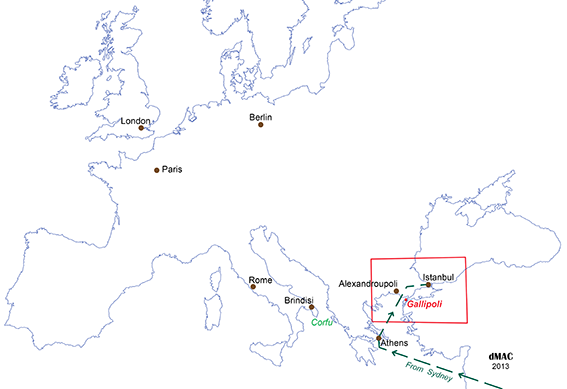
Map of GallipoliPeninsular
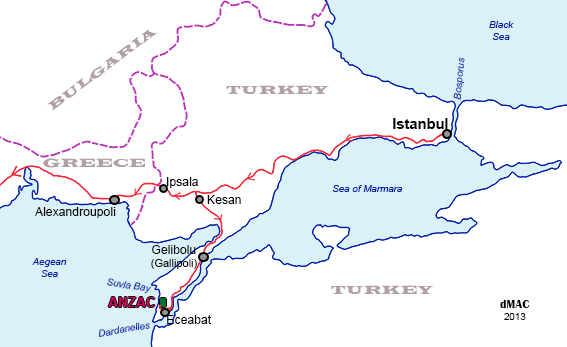
Route taken by Duncan 8-May-1975
All maps andphotos by Duncan MacDonald unless otherwise stated.
* * * * *
Chapter 1 - Background
T his is a record of my journey to Anzac Cove in1975. I am writing this almost 39 years after the event, memorycan be deceptive so I refer to at times to my travel diary. I mightadd that that was the first time I kept a diary and I find now someentries are extremely cryptic and at times my handwriting less thanlegible.
You may well askwhy would a then 34 year old, single Australian male, decide tovisit such an isolated place? Anzac Cove was not shown on any maps.I will explain:
I was raised in asmall country town in northern NSW called Inverell (Gaelic forMeeting place of the swans, population 8,560). It had arather large park near the centre of town in which wasstrategically located a World War 1 artillery piece. Close by was avery large (to a small boy) pine tree, which by local tradition wasgrown from a seed taken from the Lone Pine ridge at Gallipoli.
Two brothers fromInverell, Ben and Mark Smith fought with the3rd Battalion at Lone Pine. Mark was killed and Bensouvenired several pine-cones from the pine branches used by theTurks to cover some of their frontline trenches. He sent them hometo his mother who successfully grew two seedlings. One shepresented to the town of Inverell in 1928 where it surviveduntil 2007. The other she gave to the Parks and Gardens section ofthe Department of the Interior in Canberra. This second treewas planted at the Australian War Memorial atCanberra in October 1934 by the Duke of Gloucester,in honour of Mrs Smiths and others sons who fell atLone Pine. Today it stands more than 20 metrestall . [ The InverellTimes, 26 April 2013 ]
The fact that Iwould discover later was, at that the time of that battle, whichbegan at 5:30 pm on 6th August 1915, no trees existed on thatfateful ridge. The stump of one tree is recorded in a sketch madeof Lone Pine by Sergeant-Major Goldenstedt, 3rd Battalion,on 30-July-1915. [The Story of Anzac, Vol II,C.E.W. Bean, University of Queensland Press, 1924, p497]
As a youth I had apassion for history and had read the only book available at thattime on the Gallipoli campaign in World War 1 - Gallipoli byAlan Moorehead, first published in 1956. The Official Historyof Australia in the War of 1914-1917, Volumes 1 to VI, by C.E.WBean, were not available in Inverell during my youth.
* * * *
I meet an Anzac
The event that set in motion mydecision to visit Anzac Cove was a meeting I had with a 76 year oldman in Gosford, just north of Sydney in late 1974. At the time Iwas working for a company engaged in developing commercial realestate sites and had spent considerable time chatting and drinkingtea with the owners of the residential houses which were built onland that had been re-zoned Commercial. This gentleman emigratedto Australia from England when he was 14 years old. He worked atnumerous unskilled jobs. At age 17 he fell in love with a charmingAustralian lass. Unfortunately she determined he had no prospectsand told him to get lost He was heartbroken. So he did what manyyoung men did in this situation - he joined the army.
Fast forward tothe 6th August 1915 and our heartbroken Private finds himself in atrench on the Gallipoli peninsular along with other Australiantroops awaiting the whistle that will send them over the top. Theyare endeavouring to capture a Turkish strongpoint called LonePine. He did not participate in the original landings on 25thApril 1915. He had just arrived with reinforcements fromAustralia.
As a young boy Ihad been instructed by my parents never to ask any returnedservicemen (or women) about their wartime experiences. Why Iqueried. Because they dont like talking about it, thats why.Being a dutiful son I did as I was told, although now I wish I hadbeen more adventurous and bent that rule. A number of my relativeswere returned soldiers from WW2, including uncles Gordon andRonald, but sadly they are now deceased.
However, back toGosford. Im not sure how the conversation with Private Heartbrokengot around to Gallipoli, but suddenly Im being told by thisoriginal Anzac (the only one Ive ever met), that on the eveof the battle of Lone Pine hes in a trench with a bunch ofAustralian soldiers. The trench was packed with troops about sixdeep. What amazed me was when the Private told me, the men in therear were trying to buy their way into the front rank.
I couldnt resistexpressing disbelief that anyone would want to buy their way intothe front rank when they were only hours or even minutes fromclimbing over the top of the trench and running perhaps 50 to 80meters over open ground to the Turkish trenches. These guys werentnewcomers like the Private. Many had been there since the landingat Anzac Cove on 25th April. They knew first-hand the carnage enemymachine guns and rifles could cause to troops attacking over openground. (A lesson unfortunately never learnt by the armycommanders of the Gallipoli campaign nor those on the WesternFront.)
My finalcompelling argument was What would anyone do with money anyhow?There were no shops to spend it. It just doesnt make sense.
Ah, replied myAnzac friend, the currency wasnt money. The currency waschocolate. These men were so upset at the losses they had sufferedjust by having to sit in trenches for weeks while they were snipedat and bombed by Johnny Turk, they just wanted revenge.
I considered thatfor a moment, then disregarding the advice instilled by my parentsasked Did you try and buy your way into the frontline?
He gave me quietsmile and replied I didnt have any chocolate.
I learnt over theensuing few hours that Private Heartbroken survived the Gallipolicampaign (obviously) and when the Australian, New Zealandersand other British troops were withdrawn from the GallipoliPeninsular in December 1915, was transferred to the Western Frontin France.
You were verylucky to survive three years on the Western Front. Werent you evenwounded? I asked indelicately. He responded again with a smile,that as he and his regiment were marching up to the front line,they happen to pass a couple of British officers. Apparently oneofficer observed Private Heartbroken was English and asked him ifhe wanted to be his driver. I must have looked confused. How didhe know you were English? I asked.

